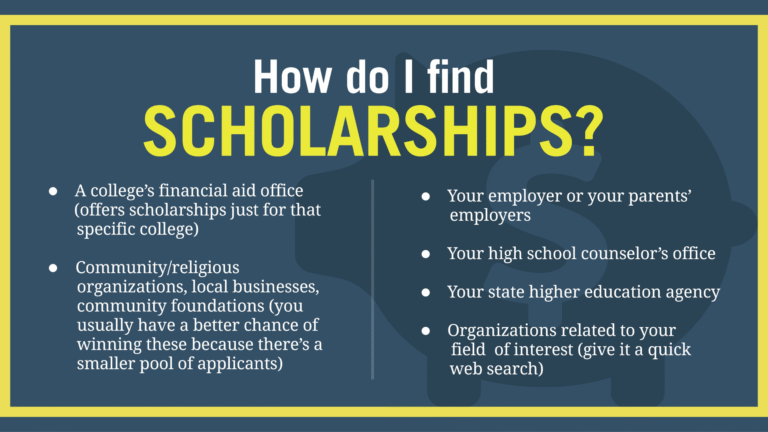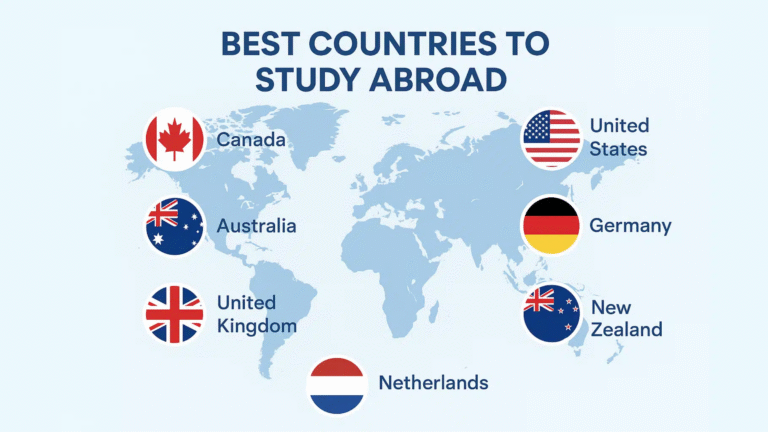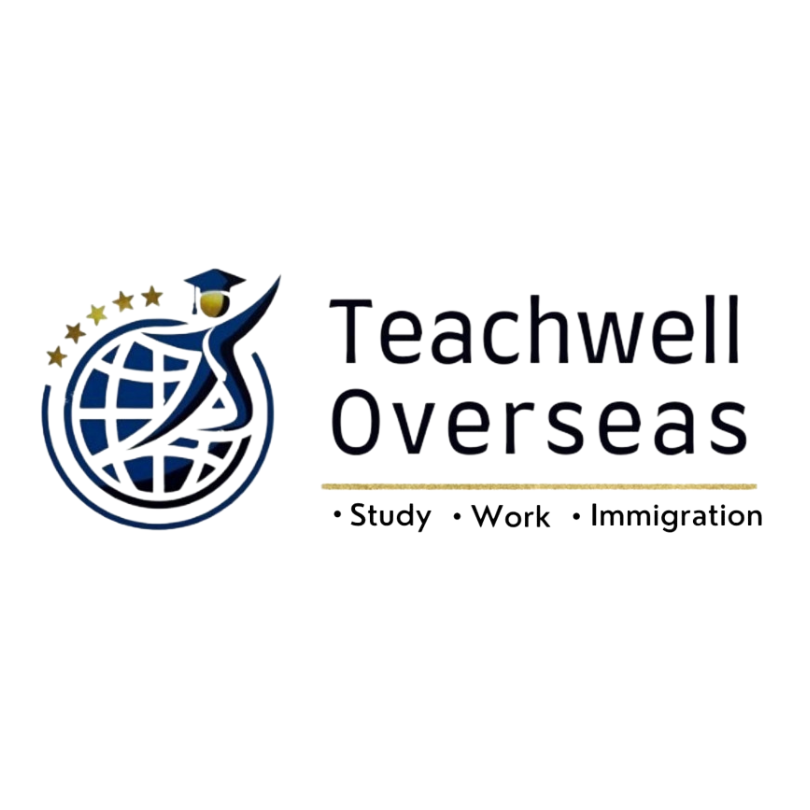Check official global scholarship portals for international students! Visit Now
Study Abroad Consultants In Delhi
Navigating Scholarships and Financial Aid for International Students
International students who aim to study abroad face numerous challenges, including financial, cultural, and academic challenges. Tuition fees, living costs, travel expenses, health insurance and other costs can quickly accumulate. Therefore, receiving scholarships and financial aid is definitely a lifeline that can sanitize studying overseas. By planning in advance and having some understanding of what opportunities exist, students are able to reduce their financial strain and concentrate on attaining academic progress, conducting research, and personal development.
In advance of the 2026 intake, universities and governments will continue to announce more and more scholarships and financial aid opportunities all around the world that are specifically for international students. The financial aid will range from merit based, to need based, to discipline based. With a plan, if Indian or international students are interested, they could fund studying at some of the best universities out there.

Why Scholarships and Financial Aid Are Vital for International Students
Studying in another country can have significant financial implications. The average costs of tuition fees for a 4-year undergraduate degree can range between $15,000 to $50,000 a year on top of that, the tuition fees for postgraduate degrees can be even higher. In addition to tuition fees, living expenses, accommodation, books, insurance, and transportation costs can easily add up to another $10,000 to $25,000 annually, depending on the country.
Scholarships and financial aid can help international students manage the costs of studying abroad. Scholarships aid students not only financially, but also open doors to academically prestigious institutions that would normally be difficult to afford. In addition to the financial advantage, many scholarships will also assist the student in developing an academic and career path through networking and professional mentorship, and often academic recognition and/or opportunities for research.
For example, a student from India who would normally need to pay out of pocket the full tuition and fees financial burden of studying in the USA for a 4-year program, could expect to save around 50–70 lakh INR which can make for a much more financially reasonable process. Conversely, studying in Europe very often will see the tuition costs completely covered outside of the fees to enroll, allowing students to mostly focus on curriculum, research, and internships beyond academic priorities instead.
Types of Scholarships for International Students
Scholarships for international students can be broadly categorized into merit-based, need-based, government-sponsored, and university-specific awards. Each type serves a distinct purpose and has its eligibility requirements.
Merit-Based Scholarships
Merit scholarships recognize academic merit, leadership, innovation, and/or unique arts, sports, or research talent. They focus primarily on GPA, standardized test scores, and extracurricular activities for undergraduate students. Eligibility for merit scholarships for postgraduate students may involve prior research experience or publication history.
Some of the world’s foremost universities, like Harvard, Stanford, and Oxford, have merit scholarships for international students; these scholarships cover tuition fees, and other possible living expense allowances. The competition is often intense, and strong academic records and/or compelling personal statements are usually required for general funding.
Need-Based Scholarships
Financial aid based on need is for students with demonstrable financial need. Students need to provide individualized information about the family income, assets and liabilities, and the universities determine how much financial aid is necessary. Financial aid based on need guarantees qualified students whose financial barriers would prevent them from studying abroad the ability to study abroad.
In the USA specifically, Ivy League schools are well known for providing generous need-based aid to international students up to 100% of tuition and living costs. Many universities in Canada, Australia and Europe also have need-based grants or bursaries.
Government-Funded Scholarships
Scholarships are offered by governments around the world, and their intention is to attract talent from around the world. Some of the more well-known programs offer scholarships, including:
Fulbright Program (USA): For graduate study, research, or teaching.
Chevening Scholarships (UK): Full funding for a one-year master’s program.
DAAD Scholarships (Germany): For research and postgraduate programs in various areas.
Australia Awards: Scholarships for students from Asia, Africa, and the Pacific.
Scholarships funded by the government cover tuition, travel, living expenses, and perhaps health insurance. Applications are competitive and extremely demanding, usually requiring exceptional academic and demonstrated leadership credentials.
University-Specific Scholarships
A lot of institutions of higher education have scholarships for international students specifically. Some of these scholarships are tuition waivers, grants, research assistance, and fellowships. Sometimes, individual departments at colleges and universities have awards that are only available to students pursuing particular educational interests or subjects, or specific research projects.
For instance, the University of Toronto has what they describe as International Scholar Awards. These scholarships are merit-based, awarded as partial tuition-waivers, and competitive. Likewise, at the University of Melbourne, international students may be eligible for a variety of scholarships and fellowships based on merit, need, or research potential.
Additional Financial Aid Options
Financial aid for international students is not limited to scholarships. Universities and organizations provide alternative ways to offset costs.

Grants and Fellowships
Grants and fellowships are often pinpointed to research, internships, or leadership initiatives. They typically do not require repayment, and they may provide incidental mentorship or professional development opportunities. Fellowships, such as MIT’s International Science and Technology Initiatives (MISTI) program, combine funding with an in-depth research experience abroad.
Work-Study Programs
A number of universities provide on-campus part-time employment for international students. Opportunities may include research assistance, library assistance or administrative activities. Though part-time work may not cover all expenses, it can provide some immediate financial relief and some experience.
Assistantships
Teaching assistantships or research assistantships offer money and academic development. Graduate students are frequently placed with faculty to assist with research or teaching. In return, they receive a stipend and tuition waiver in exchange for completion of work. Programs that are competitive in the USA, Canada, and Europe utilize assistantships to woo talent from other countries.
Loans and Education Financing
Education loans are increasingly sought after by international students. Banks and financial institutions have made education loans specifically for studying abroad available. Some of these loans can be repaid on a flexible basis, and the funding accounts for tuition, living expenses, and travel to school. Internationally, many universities are investigating innovative educational funding models like Income Share Agreements (ISA).
Explore more funding tips and guides for international students! Read More
How to Find Scholarships and Financial Aid
Identifying scholarship opportunities requires careful research and planning. Here are the most effective sources:
University Websites and Portals
All universities maintain an updated and fully searchable list of available scholarships and aid programs on their official websites. Students should take time to review eligibility and deadline dates, check any documentation that may be requested, and analyze coverage of award. Academic departments may also have additional scholarships that are less widely known but still can assist with students’ costs.
Government and Embassy Resources
You can find information about scholarships for international students on the embassies and government portals that each country provides so students can find scholarships by region or exchange programs, and many governments promote their most talented students to study abroad and return to study in their home country.
Lorem ipsum dolor sit amet, consectetur adipiscing elit. Ut elit tellus, luctus nec ullamcorper mattis, pulvinar dapibus leo.
Online Scholarship Databases
Websites like Scholarships.com, StudyPortals, and international education platforms provide searchable databases. Students can filter scholarships by country, field, or level of study to identify relevant opportunities efficiently.
Alumni Networks and Mentorship
Contacting current students or alumni may be an essential step in receiving candid advice in relation to scholarship opportunities or how to strengthen your application. In addition to social media forums, using LinkedIn groups and forums of student communities may also prove to be resources of valuable scholarship information, specifically scholarships that involve lesser-known information and the selection process.

Strategies to Maximize Scholarship Success
To improve the chances of securing scholarships, international students should adopt a strategic approach.
Start Early
Begin researching at least 12 months before the intended intake. Early preparation allows sufficient time to meet deadlines, gather documents, and refine applications.
Tailor Each Application
Each scholarship has unique priorities. Customize your application to align with the scholarship’s goals—whether academic achievement, leadership, innovation, or community impact.
Craft Strong Personal Statements
A strong personal statement or statement of purpose can set you apart. Describe past academic accomplishments, career aspirations, reasons for wanting to study abroad, how the scholarship will help you achieve your goals, etc. Just be true to yourself and be clear.
Secure Strong Letters of Recommendation
Letters from professors, mentors, or employers should emphasize your achievements, potential, and contribution to the academic community. Provide recommenders with necessary details and deadlines to ensure impactful letters.
Organize Documents
Be sure to request transcripts, financial statements, certificates, and other materials needed in a complete and thorough manner. A student may be disqualified from financial aid even if they are otherwise eligible due to missing documents.
Top Countries Offering Scholarships for International Students
United States
Programs like the Fulbright, the Hubert H. Humphrey Fellowship, and awards from specific universities generally support international students. Need-based financial support is also familiar at Ivy League schools, which often help pay for full tuition and living expenses.
United Kingdom
Chevening Scholarships, Commonwealth Scholarships, and other university-level awards provide substantial funding for international students. Research grants and teaching assistantships supplement financial aid.
Canada
Canada offers both merit-based and need-based scholarships. The Vanier Canada Graduate Scholarships and Canada Graduate Scholarships support research-intensive programs for international students.
Germany
DAAD Scholarships and tuition-free public universities make Germany an attractive destination. Scholarships often cover travel, research, and living costs.
Australia & New Zealand
Australia Awards and New Zealand Scholarships provide financial support for tuition, living expenses, and travel. Universities like ANU, UNSW, and Melbourne offer additional merit-based scholarships.

1. Can international students apply for multiple scholarships at the same time?
Yes, but some scholarships may restrict concurrent acceptance. Check specific terms before applying.
2. Are scholarships only merit-based?
No, scholarships can be merit-based, need-based, or focused on specific fields or demographics.
3. Do scholarships cover living expenses?
Some scholarships are full-ride, covering tuition, living costs, travel, and insurance. Others provide partial aid.
4. How important is a personal statement?
It is crucial. A strong personal statement can set your application apart even if other students have similar academic scores.
5. Can working part-time affect my scholarship?
Typically, on-campus part-time work does not impact scholarships, but always check the specific conditions.
6. What are common sources for international student scholarships?
Sources include universities, governments, non-profits, foundations, and private organizations. Online databases are the most efficient way to find relevant scholarships.
7. How can students increase their chances of winning a scholarship?
Early preparation, tailored applications, high academic performance, extracurricular engagement, and strong letters of recommendation all improve chances.
Conclusion:
International students rely on scholarships and financial aid to achieve their study abroad vision and goals. With sufficient time for planning, conducting research, and applying in a strategic manner, students can ease the financial burden of studying abroad, and also gain access to top universities and global opportunities.
By better understanding the types of scholarships, how to apply for scholarships, and understanding financing options available, international students can confidently navigate the complexities of financial aid. Scholarships relieve the costs of an international education, but also provide expanded professional connections, classroom learning, and international perspectives.
With the power of determination, research, and planning, international students can access opportunities that can lead to academic achievement, advancement of professional studies, and life experiences in a global context.
